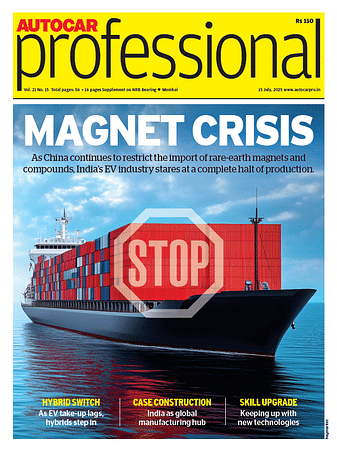2012 Western India Special: ZF all set to expand India product range
In India, ZF’s existing portfolio includes products like car chassis, steering system, links, components, in addition to truck transmissions and axles for off-road applications like agricultural equipment.
ZF Friedrichshafen AG, the world’s ninth largest automotive components and systems supplier, aims to grow its annual turnover from 2011 level of 15.5 billion euros to 20 billion euros by 2020 (17 billion euros, a 10 percent growth target for 2012). The share from the Asia-Pacific region is set to grow from 2.62 billion euros to 2.91 billion euros (Rs 20,180 crore) in this period.
“Our key growth bets are on Singapore, Malaysia, Indonesia and Thailand. Much emphasis will also be placed on the marine industry in Vietnam, commercial and passenger vehicle business in India, and mining in Australia, just to name a couple,” says Dr Peter Ottenbruch, executive vice-president, technology, ZF Friedrichshafen AG and board member, ZF Group. Towards achieving its targets, ZF says it will invest 1.5 billion euros each in 2012 and 2013.
ZF’s business in India is, at present, heavily tilted towards commercial vehicles. Of the planned introductions, the electric power steering (EPS) will be the most significant which ZF hopes will enable it to increase its share of business from passenger OEMs. Dr Ottenbruch says, “Given the weight range of cars in India, EPS will be better because it offers benefits like power-on-demand which reduces fuel consumption. It can also be used in SUVs and light commercial vehicles.”
ZF claims its electric power steering systems can save up to 0.4 litre fuel per 100 kilometres. Called the Servoelectric, it consumes over 90 percent less power than hydraulic steering systems. The steering system will be supplied by the Pune-based ZF Lenksysteme, a joint venture between ZF and Bosch.
The Servoelectric has now made its debut in China where the company has a confirmed order for 60,000 units annually. ZF is currently in talks with Tata Motors for the Servoelectric. Among Tata cars, it may also find its way into the Nano.
In India, ZF’s existing portfolio includes products like car chassis, steering system, links, components, in addition to truck transmissions and axles for off-road applications like agricultural equipment. The company plans to add EPS, new-generation transmissions and axles for off-road applications. New additions in the CV axle systems are also on the cards. In the components business, pedal boxes and clutch systems will likely be offered to passenger vehicle OEMs. ZF also plans to design and develop products keeping in mind the requirements of developing markets like India. “The transmissions we sell in India today are either high-end transmissions or specially-localised transmissions. However, we have to now go where the market goes,” says Dr Ottenbruch.
As ZF reduces its dependence on European markets, markets in the Asia-Pacific region are set to get more importance in ZF’s global plans. The company plans to bring down the share of business from Europe to 56 percent of total sales in 2017. Its target for 2012 is 61 percent, down from 72 percent in 2007. ZF’s business in the Asia-Pacific region grew 25 percent during the January to August 2012 period, compared to January-August 2011. Global sales grew 16 percent year-on-year during the first eight months of 2012.
Focus on new technology, materials
ZF has improved its world ranking among automotive suppliers by 10 rungs, from 19th in 2000 to ninth in 2011. Increased innovation and more cost effective solutions are crucial for it to move further towards the top. It has an internal vision to be among the top three suppliers in every segment it operates in. Engineers at ZF, which spends around five percent of its annual sales on R&D (750 million euros in 2011), are working on new materials and new components/systems architecture to meet stringent environment related norms.
The German supplier’s chassis technology division has come up with a few options to reduce weight of a car chassis. These include pedals, dampers, suspension struts and complete axle made of aluminium, magnesium or glass-fibre-reinforced plastic (GRP). A combination of the options leads to a lighter chassis, which in turn means fuel efficiency and improved vehicle dynamics, comfort and safety.
One lightweight concept that is slated to go into a production car by 2015 is the rear axle with a wheel-guiding transverse spring made of GRP. The 12-15 percent weight reduction compared to a conventional rear axle made of steel is one advantage.
In contrast to the complex multilink concept, in the ZF design one component – the wheel guiding transverse spring – takes on the tasks of wheel guidance, bounce and roll suspension. ZF says, in the future, the lightweight concept can be produced in high volumes with comparable comfort and costs.
Interview with Dr Peter Ottenbruch
SUMANTRA BAROOAH
RELATED ARTICLES
Creativity Reimagined: Auto Design in the Era of Artificial Intelligence
As AI accelerates design and product cycles tighten, automotive creativity is being redefined as a race against redundan...
Magnets of Disruption: How China’s Grip on Rare Earths Is Stalling India’s EV Dreams
As China tightens its grip on rare earth exports, Indian automakers risk delayed launches, disrupted festive season prod...
HYUNDAI CRETA EV: Off to a Slow Start
Hyundai has priced the electric version of its massively popular SUV close to the Rs 20 lakh range, where it has been fo...





 By Autocar Pro News Desk
By Autocar Pro News Desk
 01 Nov 2012
01 Nov 2012
 3523 Views
3523 Views








 Autocar Professional Bureau
Autocar Professional Bureau

